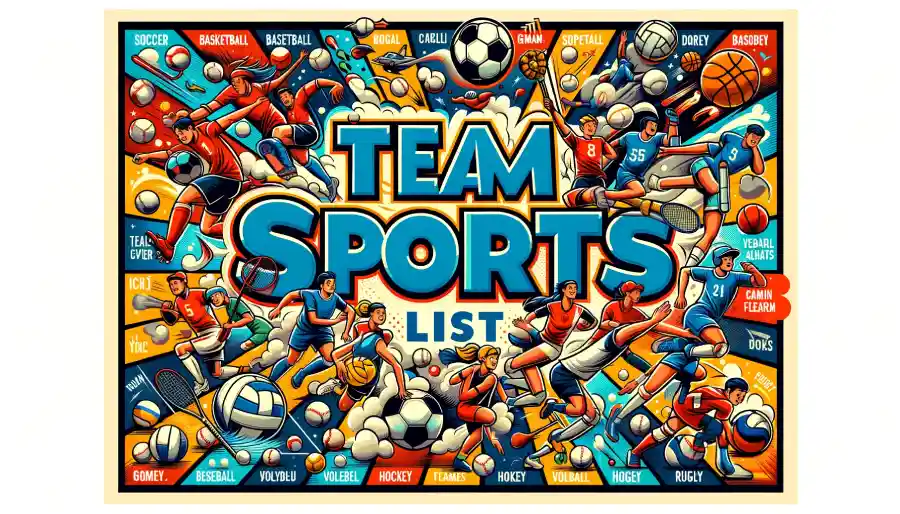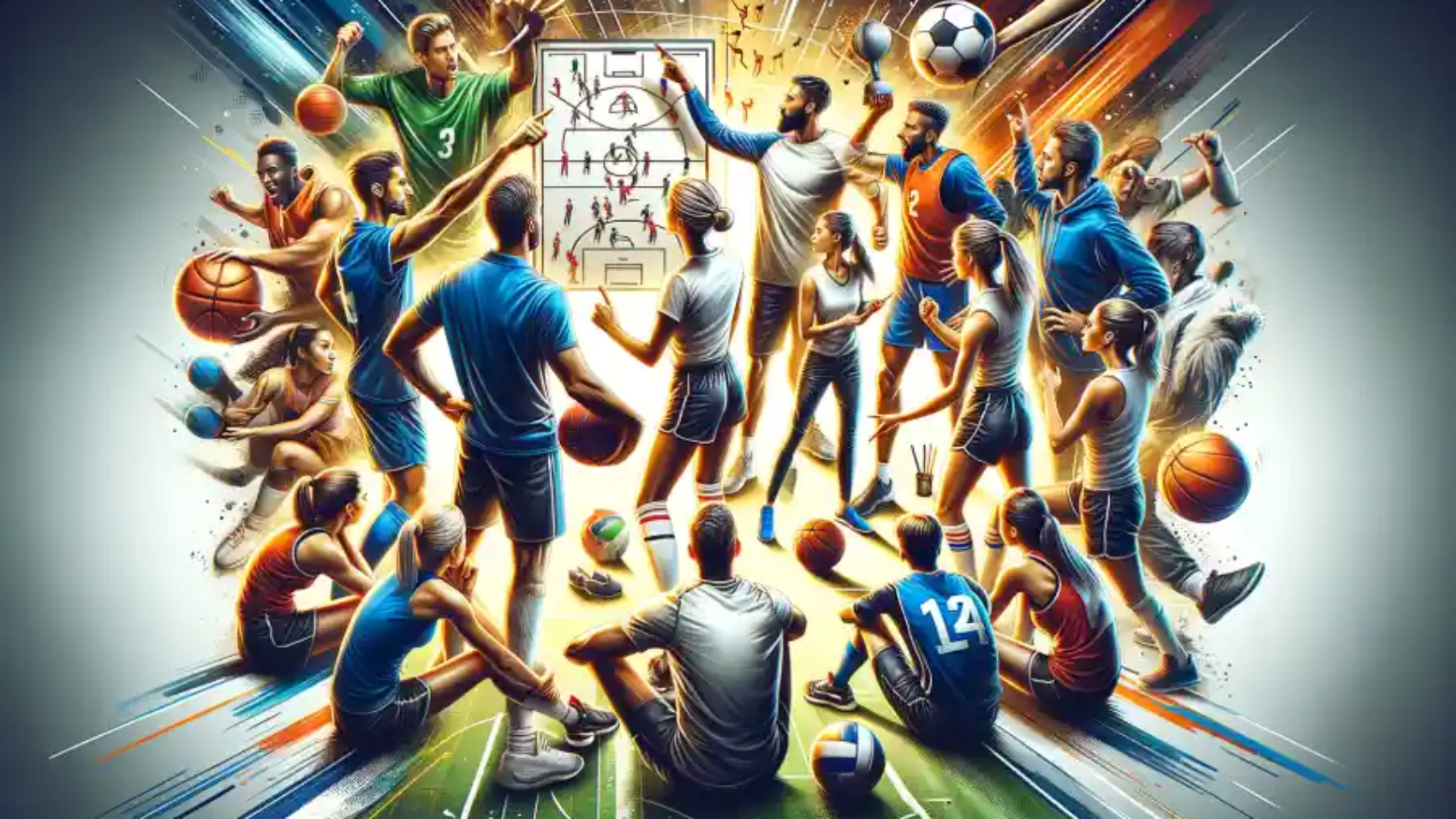Unlike individual sports, team sports require players to work together as a team. These sports include popular games like basketball, soccer, lacrosse, and hockey. In these games, players must work as a team to move a ball or something similar to score points. It’s not just about being strong or fast; it’s also about working well with others, planning together, and helping each other.
A long time ago, team sports were very important in different cultures. For example, in ancient Greece and Rome, sports were a big part of people’s lives. They used these games to bring people together and celebrate. Today, we see this in big events like the Olympics, where sports unite people worldwide.
Team sports are good for more than just playing. They teach us how to work with others, lead a group, and keep trying even when things are tough. These games bring together people from different places and backgrounds, making everyone feel like part of a community.
In short, team sports are about more than just winning a game. They help us learn important life skills, make friends, and bring people together. This introduction talks about how team sports started, how they help us in life, and how they make us feel united as a team.
The Concept and Evolution of Team Sports
What are Team Sports?
Team sports are games where people play together as a team. They are not just about one person; everyone has to work together. In these sports, players help each other to win the game. They plan what to do and talk to each other to make good plays. It’s like a group of friends working together to solve a puzzle.
Why Team Sports Are Important
Playing Together: In team sports, everyone has to play as part of a team. This means sharing, helping, and supporting each other.
Making Plans: Teams have to think and make plans on how to win. They need to decide how to play against the other team.
Talking and Understanding: Players need to talk to each other and understand what each person is good at. This helps them play better together.
History
Sports have a long history, stretching back to around 70,000 BCE. Initially, they were closely tied to military training and entertainment. Over time, sports have evolved into various forms and have become an integral part of cultures worldwide.
In ancient civilizations like Sumer and Egypt, sports played a significant role. Sumerian civilization, dating back to around 3000 BCE, featured wrestling, as depicted in various artifacts. Similarly, in Egypt, around 2000 BCE, sports such as weightlifting and swimming were prevalent. These activities not only served as entertainment but also as means of physical training.
Ancient Greece marked a pivotal point in sports history with the inception of the Olympic Games in 776 BCE. These games included events like running and boxing and were a significant part of Greek culture. Other Greek sporting events also gained popularity, showcasing the growing importance of sports in societal and cultural contexts.
Sports in other ancient cultures also developed uniquely. In Ireland, sports like hurling have been played for over 2500 years. Similarly, the Mayans in Central America had an early form of a ball game around 2500 BCE. These activities were not just for physical prowess but also held social and cultural significance.
During the Middle Ages, sports took on different forms. In England and Ireland, villages engaged in rough ball games. Conversely, the upper class enjoyed sports like jousting, which were akin to military training. This period saw sports becoming more structured and organized.
The Renaissance brought a shift in the perception and role of sports. They became more recreational, moving away from their earlier associations with military training. This era also saw the formation of sports clubs and the establishment of standardized rules, laying the groundwork for modern sports.
The Industrial Revolution significantly influenced modern sports development, which provided people with more leisure time. Many team sports we know today originated in the West during this period. However, this era also saw the rise of cheating in sports, such as the use of performance-enhancing drugs.
In England, sports like cricket, horse racing, and boxing were not only popular but often involved gambling. These sports evolved over time, with rules and structures that influenced their modern counterparts. The history of sports reflects the societal changes over the millennia, evolving from activities tied to survival and military training to forms of entertainment, physical fitness, and professional competition.
Team Sports List

Teamsports are activities in which individuals are organized into opposing teams which compete to win. These sports are characterized by a sense of cooperation and interdependence among team members as they work together to achieve a common goal. Here’s a detailed team sport examples list of some popular team sports games:
Top 10 Sports in The World
| Rank | Sport | Description | Global Reach |
| 1 | Soccer (Football) | The most popular sport globally, involving two teams trying to score goals in the opposing net. | Europe, Africa, Asia, Americas |
| 2 | Cricket | A bat-and-ball game with massive following, especially in the Commonwealth countries. | India, UK, Australia, Pakistan |
| 3 | Basketball | A fast-paced game where two teams compete to score by shooting a ball through a hoop. | USA, Canada, China, Europe |
| 4 | Hockey (Field and Ice) | Includes both field hockey and ice hockey, known for its speed and skill. | Europe, Canada, India, USA |
| 5 | Tennis | A racket sport played individually or in pairs, with a significant global following. | Worldwide |
| 6 | Volleyball | A team sport where two teams try to ground the ball in the opponent’s court. | Worldwide |
| 7 | Table Tennis | Known for its fast pace and precision, popular in many countries. | Asia, Europe, Americas |
| 8 | Baseball | A bat-and-ball game primarily popular in the USA, Japan, and parts of Central and South America. | USA, Japan, Caribbean |
| 9 | Golf | A club-and-ball sport where players hit balls into a series of holes with the fewest strokes. | USA, Europe, East Asia |
| 10 | Lacrosse | Players use a lacrosse stick to shoot a small ball into the opponent’s goal. Growing popularity in North America. | United States, Canada |
Team Sport Benefits
Playing team sports has many physical and mental benefits. Here are some of the key advantages:
- Physical Fitness: Joining a team sport is a great way to improve your physical fitness. They often involve running, jumping, and quick movements that help build endurance, strength, and flexibility.
- Social Skills: Playing on a team teaches important social skills like cooperation, communication, and teamwork. Working together toward a common goal is a valuable skill that can be applied in many other areas of life.
- Discipline and Responsibility: Being part of a team requires discipline, such as attending practices and following team rules. Players also learn responsibility, as their actions can affect the whole team.
- Stress Relief: Physical activity, like playing sports, is a great way to relieve stress and anxiety. It releases endorphins, which are natural mood lifters.
- Building Confidence: Succeeding in sports can boost self-esteem and confidence. Even when not winning, players learn resilience and the ability to bounce back from setbacks.
- Developing Leadership Skills: Team sports often create opportunities for leadership. Players can learn to lead by example, motivate others, and make strategic decisions.
- Time Management: Balancing sports with other responsibilities teaches time management skills. Players learn to prioritize and manage their time effectively.
- Making Friends: Team sports are a great way to meet new people and build friendships. The shared experiences and goals can create strong bonds between teammates.
- Understanding Winning and Losing: Team sports teach players how to handle both success and failure. Learning to win gracefully and lose with dignity are important life skills.
- Long-Term Health Benefits: Regular physical activity through team sports can reduce the risk of many health issues, such as obesity, heart disease, and diabetes.
Taking part in team sports can promote a healthier, more active lifestyle and provide valuable life lessons and social experiences.
Olympic Team Sports

The Olympic Games feature several team sports. These sports are part of both the Summer and Winter Olympics. Here’s a list of current Olympic team sports:
| Summer Olympics Team Sports | Description |
| Football (Soccer) | Teams compete in a tournament format. |
| Basketball | Includes traditional 5-on-5 and 3×3 formats. |
| Volleyball | Both indoor volleyball and beach volleyball. |
| Handball | A fast-paced game played indoors. |
| Hockey | Field hockey, played on grass or turf. |
| Rugby Sevens | A faster variant of rugby with seven players. |
| Water Polo | A water-based sport played in a swimming pool. |
| Baseball/Softball | Baseball for men and softball for women. |
| Winter Olympics Team Sports | Description |
| Ice Hockey | A fast-paced game played on an ice rink. |
| Curling | Teams slide stones towards a target on ice. |
| Bobsleigh | Includes two-person and four-person events. |
| Luge Relay | A team event with athletes competing in a relay. |
| Mixed Gender Team Sports | Description |
| Mixed Doubles Curling | Teams consist of both men and women. |
| Mixed Team Events | In sports like Badminton, Table Tennis, Triathlon. |
These sports are subject to change as the International Olympic Committee (IOC) regularly reviews and updates the Olympic program. New sports and disciplines can be added, and existing ones can be modified or removed based on various factors, including global popularity and inclusiveness.
Conclusion
In conclusion, team sports play a crucial role in fostering unity and personal growth. They bring individuals together, creating a sense of camaraderie and teamwork that transcends individual differences. Life skills gained through team sports include cooperation, communication, discipline, and leadership. These activities also promote physical health and mental well-being, contributing to the overall development of individuals.
Reflecting on the enduring appeal of team sports, it’s evident that they have a universal charm that cuts across different cultures and times. From ancient civilizations to the modern Olympic Games, team sports have been a constant feature, bringing people together for both competition and celebration. This universal appeal is rooted in the human desire for social connection and the joy found in shared experiences and achievements.
The continuous evolution of team sports is a testament to their significance in society. Over time, these sports have adapted to changing social norms and technological advancements, making them more inclusive, diverse, and accessible. Team sports continue to evolve today, embracing new formats and technologies and reaching wider audiences. Their ability to adapt while maintaining their core values of teamwork and fair play ensures that team sports will remain a vital part of human culture for generations to come.
In essence, team sports are more than just games; they are a reflection of our society, mirroring our values and aspirations. They provide a platform for individuals to come together, learn, grow, and celebrate the human spirit in all its diversity and unity.


[…] team members to work on the same presentation simultaneously. This feature facilitates efficient teamwork, ensures seamless integration of ideas, and improves the overall quality of the presentation […]
[…] challenges, and embark on a fulfilling journey of continuous learning and personal development. Team sports embrace the growth mindset and watch as doors of opportunity swing wide open, leading to a path of […]